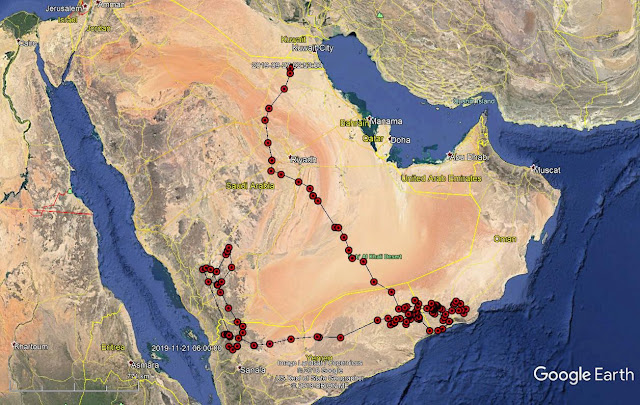by F. Al Lamki, B. Meyburg, M. McGrady & A. Spalton.
The "winter" has arrived for the Steppe eagles. Most have now ceased concerted migration. Some have settled into fairly small home ranges, especially where there is a reliable source of plentiful food, like a landfill or rubbish dump. Those birds are moving almost exclusively between where they spend the night and those food sources. Other birds, like the one whose movements are shown below, apparently don't find a single source of abundant, reliably available food.
The bird mapped below, 186, migrated into Arabia on 28 September, and flew to Salalah, where it spent last winter. Finding the rubbish dump there closed, it moved back to Yemen, then to SW Saudi, and is now back in NW Yemen. One can see clusters of locations along this route, where the eagle probably found enough food for it to dwell there for some time.
The map also shows that his bird passed through the area of Central Saudi, where the large aggregation of Steppe Eagles was located with the help of our transmitter data. Click here to read ore about that.
The "winter" has arrived for the Steppe eagles. Most have now ceased concerted migration. Some have settled into fairly small home ranges, especially where there is a reliable source of plentiful food, like a landfill or rubbish dump. Those birds are moving almost exclusively between where they spend the night and those food sources. Other birds, like the one whose movements are shown below, apparently don't find a single source of abundant, reliably available food.
The bird mapped below, 186, migrated into Arabia on 28 September, and flew to Salalah, where it spent last winter. Finding the rubbish dump there closed, it moved back to Yemen, then to SW Saudi, and is now back in NW Yemen. One can see clusters of locations along this route, where the eagle probably found enough food for it to dwell there for some time.
The map also shows that his bird passed through the area of Central Saudi, where the large aggregation of Steppe Eagles was located with the help of our transmitter data. Click here to read ore about that.
 |
| Movements of a Steppe Eagle during 28 Sept - 21 Nov 2019, (To view the map better, try double-clicking on it) |








































